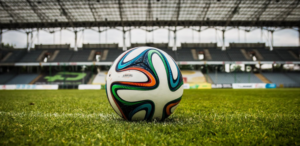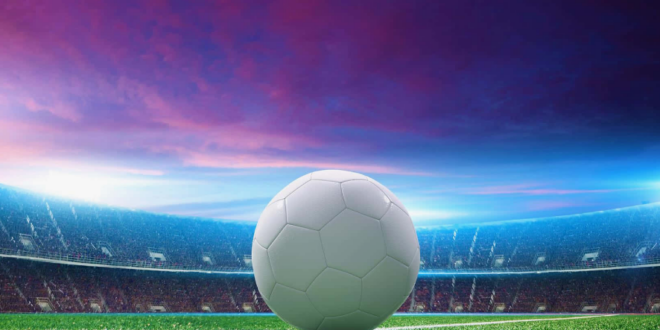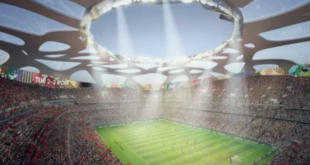The regulation soccer field must be rectangular and marked with specific dimensions, as outlined by the International Football Association Board (IFAB). It is crucial to follow these guidelines to ensure a fair and standardized playing field for all teams and players. A soccer field, also known as a football pitch or football ground, is the playing surface for soccer matches. It is an essential aspect of the game and must meet certain qualifications to be considered a regulated soccer field. The field must be rectangular, with specific dimensions, and marked with lines to determine the areas of play.
These markings include the center circle, penalty area, and goal area. We will explore the various aspects of a regulated soccer field, including the dimensions and markings, to help understand the requirements for a fair and competitive game.

Table of Contents
Dimensions of A Regulation Soccer Field
A regulation soccer field is rectangular and measures between 100-130 yards in length and 50-100 yards in width. The field is divided into two halves, with each side containing a penalty area and a goal.
The dimensions of a regulation soccer field are one of the most critical aspects of the beautiful game. A proper playing surface is essential to ensure the comfort and safety of players and maintain the integrity of the game. Various governing bodies worldwide set guidelines regarding soccer field size, shape, and markings. Here we’ll discuss the standard dimensions of a regulation soccer field that ensures a level playing ground for professional and amateur players alike.
Length
At the professional level, a soccer field’s standard length ranges from 100-130 yards (90-120 meters) for adults. International matches must adhere to a minimum length of 100 yards (110 meters) and a maximum length of 130 yards (120 meters). Meanwhile, youth varieties have a smaller playing area, with sizes ranging from 70-80 yards (64-73 meters). The field’s length runs as a sideline from one goal line to the other.
Width
The soccer-field width is also critical to provide a fair surface for both teams. The FIFA laws of the game require a minimum width of 50 yards (45 meters) and a maximum length of 100 yards (110 meters) for adults. The goalposts must be the same width as the crossbar and extend at least 8 yards (7.32 meters) into the field’s playing surface. The width runs as the goal line from one sideline to the other.
Field Layout
In addition to length and width, a proper soccer field must follow specific guidelines for its layout. The field must be marked with boundary lines on the outer edges and two goal lines on each side. For international competitions, the field’s surface should be natural or artificial grass and have specific dimensions, as mentioned earlier. In conclusion, regulation of soccer field dimensions is critical to ensure the game’s integrity, promote player safety, and provide a level playing field for teams. By following the set guidelines and regulations, we can provide a standard soccer field size that benefits players of all ages and abilities.
Markings on A Regulation Soccer Field
A regulation soccer field is marked with various lines and markings to indicate the boundaries of the field, goal areas, penalty areas, and corner areas. The field must be rectangular and measure between 100-130 yards in length and 50-100 yards in width, according to official regulations.
A regulation soccer field is carefully marked and measured to ensure a fair game. The field must be rectangular and marked with both permanent and temporary lines. The dimensions of a regulation soccer field vary but must fall within certain length and width guidelines that are dictated by the International Football Association Board (IFAB).
Center Circle
The center circle is located in the center of the field and has a radius of 10 yards. At the start of the game, the ball must be placed in the center circle and the opposing team must stand outside the circle until the ball is in play.
Penalty Box
The penalty box, also known as the 18-yard box, is located at each end of the field and extends 18 yards from the goal line into the field. Within the penalty box is the penalty spot, which is 12 yards from the goal line and is used for penalty kicks.
Goal Box
The goal box, also known as the 6-yard box, is located within the penalty box and extends 6 yards from the goal line into the field. The goalkeeper is the only player who is allowed to handle the ball within the goal box. The touchline is the line that runs along each sideline of the field, and the goal line is the line that runs along each end of the field. These lines are considered permanent and are not removed between games. In addition to the permanent lines, temporary lines may be added to the field for specific games or events. These lines may include lines to mark corner kicks or other boundary lines. A regulation soccer field is an essential part of the game, providing a standard and fair playing surface. By understanding the markings on a regulated soccer field, players can better understand the rules and strategies of the game.

Goals And Nets on A Regulation Soccer Field
A regulation soccer field measures 100-130 yards in length and 50-100 yards in width. It is a rectangular field with two goals, each measuring 8 feet in height and 24 feet in width, placed on opposite ends of the field. The soccer nets are attached to the goals and should be able to stop a soccer ball from passing through.
Goals and Nets on a Regulation Soccer Field The goals and nets on a regulation soccer field are essential components of the game. These structures define the objective of the game and enable players to score points. Understanding the dimensions and materials of the goals and nets is crucial for players, coaches, and fans alike. Goal Size A regulation soccer field measures between 90-120 meters in length and 45-90 meters in width. The regulation soccer goal size is 24 feet (7.32 meters) wide and 8 feet (2.44 meters) tall. The goalposts and crossbar must be made of wood, metal, or another material approved by the International Football Association Board (IFAB). The goalposts and crossbar must not exceed 12 centimeters (5 inches) in width, flat, and not rounded. Net Material The soccer net is typically made of nylon or polypropylene and is attached to the back of the goalposts and crossbar. The mesh size of the net must be between 10-12 centimeters (4-5 inches), and its color must be white. Ensuring the net is the correct size and material is essential because it helps players and referees determine whether a goal has been scored. If the ball passes through the net and between the goalposts, it is counted as a point. If the ball passes outside the goalposts or above the crossbar,
The surface of A Regulation Soccer Field
A regulation soccer field is rectangular, measuring 100-130 yards in length and 50-100 yards in width, with goals at either end. The field is marked with lines for different sections of play, such as the sidelines, penalty areas, and midline.
Regulation soccer fields are typically used for professional and amateur soccer games. The standard size of a regulation soccer field is around 100-130 yards long and 50-100 yards wide. The size of the field varies depending on the level of play, but a regulated soccer field must always adhere to specific dimensions. However, the surface of a regulated soccer field can either be natural grass or artificial turf.
Natural Grass vs. Artificial Turf
Natural grass and artificial turf each have their advantages and disadvantages. Natural grass is the traditional and most commonly used surface for soccer fields. Its unique texture, color, and smell enhance the overall experience of watching or playing matches. In addition, playing on natural grass is generally accepted as being better for player safety, especially for professional matches. On the other hand, artificial turf has several benefits too, including greater durability, reduced maintenance and care expenses, and greater adaptability to different weather conditions. Although it can be more expensive initially, artificial turf requires less maintenance over time and is more long-lasting than natural grass. It also allows teams to play games in all weather conditions, minimizing schedule delays and cancellations.
Maintenance
Whether it’s natural grass or artificial turf, maintaining a regulated soccer field is crucial to ensuring high-quality gameplay. Maintenance for natural grass fields includes regular watering, mowing, and fertilizing, along with other tasks. For artificial turf, maintenance is typically easier and less frequent. Tasks such as cleaning and possibly adding new infill material are necessary for ensuring the longevity and safety of the playing surface. Overall, choosing between natural grass and artificial turf is a matter of considering the unique goals and requirements of the soccer field’s organization. However, no matter what surface is chosen, proper maintenance is necessary to ensure optimal playability on a regulated soccer field.
Fifa Regulations For A Regulation Soccer Field
A regulation soccer field is rectangular, marked with boundary lines, and has specific dimensions that vary depending on the level of play. The International Football Association Board (IFAB) sets these regulations which include specific sizes for the playing area, goal areas, and penalty areas.
FIFA Regulations for a Regulation Soccer Field Soccer is one of the most popular sports in the world, and it’s played in fields of different shapes and sizes. However, if you’re looking to set up a soccer field that meets the international standards and guidelines, then you should follow the FIFA regulations for a regulation soccer field. Here are some of the important guidelines to consider: Safety guidelines When setting up a regulation soccer field, safety should be your top priority. You need to ensure that the field is safe for players, officials, and spectators. Some of the safety guidelines to consider include: ensuring the field is fenced and secure to prevent unauthorized access. – Make sure there’s adequate space around the field to prevent collisions with objects or people outside the field. – Install proper lighting to enable visibility in low-light conditions. – Make sure the surface of the field is free from holes, rocks, or debris that could cause injuries. Equipment requirements To ensure that the soccer field meets FIFA regulations, you need to have the right equipment. Some of the equipment that you should have on the regulation soccer field includes: – Soccer ball – Soccer net – Field markers that are easy to see and identify – Corner flags – Official soccer goals that meet high school soccer field dimensions – A line marker for accurate lines and markings The soccer field size in feet should also meet the FIFA standards and have the appropriate dimensions. A regulation soccer field should measure between 100-130 yards long and 50-100 yards wide.
Locating A Regulation Soccer Field
Locating a regulated soccer field can be tricky, but with proper research, you can find the right one for your needs. Factors to consider include size, markings, and location, and websites like Wikipedia, Net World Sports, and Jobs in Football can provide helpful information on regulations and dimensions.
Finding Available Fields
Finding a regulated soccer field can be challenging, especially if you don’t know where to look. You can start your search by checking local parks and recreation departments, nearby universities, and private facilities. It’s essential to narrow down your search to fields that meet the regulation size. According to FIFA regulations for soccer fields, the length of professional soccer fields must be between 100-130 yards long and 50-100 yards wide, while youth soccer field dimensions can vary, and it depends on the age group.
Cost To Rent
The cost to rent a regulated soccer field varies from place to place and depends on several factors. These factors include location, season, and type of facility. Soccer fields located in high-end neighborhoods and private facilities tend to be more expensive than public fields. You can expect to pay anywhere between $50 to $500 per hour to rent soccer fields. Some private facilities may require a membership fee or annual subscription, so it’s crucial to factor in all expenses before making your decision.
Ensuring Field Adheres To Regulation Standards
Before renting a regulated soccer field, it’s essential to ensure that the field adheres to regulation standards set by FIFA. The soccer field must meet the FIFA regulations, including the field layout, soccer ball, soccer net, penalty area, and corner area. The dimensions and markings should be accurate to ensure a fair game. A professional soccer field must also have dugouts, a scoreboard, and floodlights to meet the regulations. In conclusion, locating a regulated soccer field requires patience, research, and a bit of luck. By following these steps, you can find the perfect soccer field that fits your budget and meets regulation standards.
Playing Soccer on A Regulation Soccer Field
A regulation soccer field measures 100 to 130 yards long and 50 to 100 yards wide. It has markings for the sidelines, end lines, penalty area, penalty spot, center circle, and corner kicks. Playing soccer on a regulation field provides a challenging and exciting experience for players of all levels.
As the most popular sport globally, soccer is played all around the world, on various types of surfaces, from grass to turf. However, when it comes to competitive soccer matches, there are specific regulations in place that govern the size and layout of the field. In this article, we’ll explore the basic rules and strategies of playing soccer on a regulation soccer field.
Basic Rules Regulation Soccer Field
When playing soccer on a regulation soccer field, there are several rules that players must adhere to. Here are some to keep in mind:
- A regulation soccer field is rectangular, with a length ranging from 100 to 130 yards and a width of 50 to 100 yards.
- There are two goals, one at each end of the field, with a width of 8 yards and a height of 8 feet.
- The field is divided into two halves by a halfway line, and each half is further divided into a penalty area and a goal area.
- Each team has 11 players on the field, including a goalkeeper.
- The objective of the game is to score goals by getting the ball into the opposing team’s goal while preventing the other team from doing the same.
- Players cannot touch the ball with their hands or arms, except for the goalkeeper within the penalty area, who can use their hands.
- Players can use any part of their body to play the ball, except for their hands and arms.
- Players can be penalized for various infractions, such as committing a foul, being offside, or using excessive force.
Strategies
To play soccer on a regulation soccer field successfully, players must employ various strategies and techniques. Here are a few to consider:
- Utilize proper positioning: Understanding the field’s layout and your team’s position on the field is crucial to playing effective soccer. Players must position themselves correctly, so they’re in the right place to make plays and score goals.
- Passing and ball control: Good ball control and accurate passing are essential to success on the soccer field. Players must practice these skills to ensure they’re capable of maneuvering the ball quickly and efficiently around the pitch.
- Varying your attacks: Mixing up your team’s offensive strategies can keep the opposition guessing and create opportunities for goals. It’s essential to have a variety of offensive tactics, such as long balls, crosses, and short passes, to keep the opposing team off-balance.
- Defensive maneuvers: Solid defense is critical to keeping the opposing team from scoring. Players must work together effectively to cover the field, mark opponents, and prevent opportunities for shots on goal.
- Effective use of substitutions: Timely substitutions can have a significant impact on a game’s outcome. Coaches must be strategic in their use of player substitutions, making changes that can help freshen up the team or bolster its offensive or defensive capabilities.
Playing soccer on a regulation soccer field is an incredibly popular sport that requires a combination of skill, strategy, and teamwork. Whether you’re a longtime player or a newcomer to the game, keeping these rules and strategies in mind can help you succeed on the pitch.

Famous Soccer Stadiums With Regulation Fields
Soccer enthusiasts will appreciate visiting famous stadiums with regulation fields, where the size of the soccer field meets the standards set by governing bodies like FIFA. These stadiums provide an ideal playing surface for the world’s most popular sport.
Famous Soccer Stadiums with Regulation Fields Soccer, also known as football, is the world’s most popular sport, enjoyed by millions of fans across the globe. From amateur games on a small youth soccer field to professional matches on a massive football field, this sport has thrived for generations. Regulation soccer field measurements vary depending on the level of competition, with high school soccer field dimensions and youth soccer field dimensions being smaller than those of professional soccer. Hence, soccer stadiums need to undergo proper planning and structure to ensure that the fields are of regulation size. Camp Nou One of the most iconic soccer stadiums in the world is Camp Nou in Barcelona, Spain. Camp Nou has been the home of FC Barcelona since it was built in 1957. The soccer field size in meters is 105 meters x 68 meters, making it one of the largest regulation soccer fields in the world. Moreover, this football stadium can accommodate up to 99,354 spectators, making it the largest football stadium in Europe. Old Trafford Another famous soccer stadium with a regulation field is Old Trafford, the home of Manchester United in Manchester, England. Old Trafford has a soccer field size in feet of 116 yards x 76 yards, which is roughly equivalent to 106 meters x 69 meters. The stadium can hold up to 74,140 spectators, making it the second-largest stadium in England. Old Trafford has undergone several renovations over the years to modernize the stadium and enhance the spectator experience. Code Example:
Camp Nou
Camp Nou has been the home of FC Barcelona since it was built in 1957. The soccer field size in meters is 105 meters x 68 meters, making it one of the largest regulation soccer fields in the world. Moreover, this football stadium can accommodate up to 99,354 spectators, making it the largest football stadium in Europe.
Old Trafford
Another famous soccer stadium with a regulation field is Old Trafford, the home of Manchester United in Manchester, England. Old Trafford has a soccer field size in feet of 116 yards x 76 yards, which is roughly equivalent to 106 meters x 69 meters. The stadium can hold up to 74,140 spectators, making it the second-largest stadium in England. Old Trafford has undergone several renovations over the years to modernize the stadium and enhance the spectator experience.
Frequently Asked Questions of Regulation Soccer Field
What is a regulation soccer field?
A regulation soccer field is rectangular and marked with lines to indicate boundaries. According to the International Football Association Board, the field must be between 100-130 yards in length and 50-100 yards in width. It is commonly used in professional or competitive play.
What is the size of the FIFA soccer field?
The size of a FIFA soccer field is rectangular, and it must be marked with boundary lines. According to the International Football Association Board (IFAB), the governing body that writes the rules of soccer, the field must measure between 100-130 yards long and 50-100 yards wide.
How many yards is a regulation soccer field?
A regulation soccer field is 100-130 yards in length and 50-100 yards in width.
Conclusion
To summarize, regulation of soccer fields is crucial for ensuring that players have a fair and standardized playing surface. It is essential to follow the correct measurements and markings to create a safe and enjoyable playing environment. With the proper field layout, soccer players can improve their skills and enjoy the game without worrying about the field’s dimensions.
 SMGB TODAY Sports, Movies, TV Shows
SMGB TODAY Sports, Movies, TV Shows

